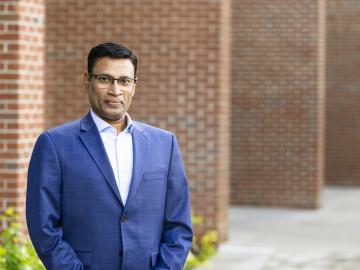
Filter News
Area of Research
- Advanced Manufacturing (1)
- Biology and Environment (40)
- Computer Science (1)
- Electricity and Smart Grid (1)
- Energy Science (39)
- Functional Materials for Energy (2)
- Fusion and Fission (2)
- Isotopes (4)
- Materials (16)
- Materials for Computing (1)
- National Security (1)
- Neutron Science (1)
- Nuclear Science and Technology (1)
- Supercomputing (12)
News Type
News Topics
- (-) Bioenergy (32)
- (-) Biomedical (20)
- (-) Clean Water (7)
- (-) Composites (8)
- (-) Energy Storage (31)
- (-) Environment (59)
- (-) Exascale Computing (13)
- (-) Frontier (12)
- 3-D Printing/Advanced Manufacturing (36)
- Advanced Reactors (7)
- Artificial Intelligence (26)
- Big Data (21)
- Biology (37)
- Biotechnology (9)
- Buildings (20)
- Chemical Sciences (26)
- Computer Science (42)
- Coronavirus (10)
- Critical Materials (3)
- Cybersecurity (12)
- Emergency (1)
- Fusion (19)
- Grid (13)
- High-Performance Computing (32)
- Hydropower (2)
- Irradiation (1)
- Isotopes (23)
- ITER (3)
- Machine Learning (15)
- Materials (43)
- Materials Science (35)
- Mathematics (5)
- Mercury (4)
- Microscopy (21)
- Molten Salt (1)
- Nanotechnology (19)
- National Security (27)
- Neutron Science (25)
- Nuclear Energy (33)
- Partnerships (11)
- Physics (23)
- Polymers (10)
- Quantum Computing (5)
- Quantum Science (11)
- Security (10)
- Simulation (15)
- Software (1)
- Space Exploration (1)
- Summit (5)
- Transportation (28)
Media Contacts

From decoding plant genomes to modeling microbial behavior, computational biologist Priya Ranjan builds computational tools that turn extensive biological datasets into real-world insights. These tools transform the way scientists ask and answer complex biological questions that advance biotechnology breakthroughs and support cultivation of better crops for energy and food security.

Jesse Labbé aims to leverage biology, computation and engineering to address societal challenges related to energy, national security and health, while enhancing U.S. competitiveness. Labbé emphasizes the importance of translating groundbreaking research into practical applications that have real-world impact.
Vilmos Kertesz, senior staff in the Biosciences Division at ORNL, has received a 2025 Al Yergey Mass Spectrometry Scientist Award from the American Society for Mass Spectrometry. The award recognizes his contributions to the fields of analytical chemistry and mass spectrometry.
Robert “Bob” Hettich, an ORNL Corporate Fellow, is a pioneer in using mass spectrometry to uncover how microbes interact within complex environments and influence larger systems like plants and humans. A founder of the field of metaproteomics, he leads research that supports bioenergy, environmental resilience and health through advanced protein analysis.
Daniel Jacobson, distinguished research scientist in the Biosciences Division at ORNL, has been elected a Fellow of the American Institute for Medical and Biological Engineering, or AIMBE, for his achievements in computational biology.
Dave Weston studies how microorganisms influence plant health and stress tolerance, using the Advanced Plant Phenotyping Laboratory to accelerate research on plant-microbe interactions and develop resilient crops for advanced fuels, chemicals and

Hugh O’Neill’s lifelong fascination with the complexities of the natural world drives his research at ORNL, where he’s using powerful neutron beams to dive deep into the microscopic realm of biological materials and unlock secrets for better production of domestic biofuels and bioproducts.

Melissa Cregger of the Department of Energy’s Oak Ridge National Laboratory has received the Presidential Early Career Award for Science and Engineers, or PECASE, the highest honor bestowed by the U.S. government on outstanding early-career scientists and engineers.

Ryan Culler is the program manager at Oak Ridge National Laboratory, where he oversees the production of actinium-225, a promising treatment for cancer. Driven by a personal connection to cancer through his late brother, Culler is dedicated to advancing medical isotopes to help improve cancer care.

Phong Le is a computational hydrologist at ORNL who is putting his skills in hydrology, numerical modeling, machine learning and high-performance computing to work quantifying water-related risks for humans and the environment.


